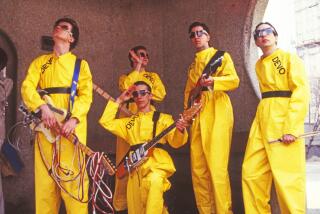SONIC BIG PILE : Underneath,Noise Is Only Half the Story
- Share via
Making music, at its most rudimentary level, is the process of giving shape to noise.
Sonic Youth has forged a distinctive niche in rock music for itself by keeping that principle in mind.
Formed in 1981, the New York City band began getting notice by the mid-’80s as a force on the burgeoning independent rock scene. It also received a tag--or epithet--to describe its approach: “noise band.”
Founding guitarists Thurston Moore and Lee Ranaldo certainly were schooled in music-as-noise. Before starting Sonic Youth, they had played with underground composer Glenn Branca, who liked to create sound-slabs by massing multiple guitars. In Sonic Youth, Moore and Ranaldo resolved to avoid the conventions of rock guitar by experimenting with (purists might say abusing) their instruments: tuning them to dissonant harmonics or inserting foreign objects such as screwdrivers among the strings.
Gradually, along with bassist Kim Gordon (Moore’s wife) and drummer Steve Shelley, the guitarists began to forge all the clangor they created into recognizable song-shapes. If noise was Sonic Youth’s inspiration, it was a version of noise handed down by such esteemed ‘60s and ‘70s rock precursors as the Velvet Underground, Patti Smith and Television. Sonic Youth’s guitars might roar and buzz and evoke a subway train hurtling into a black void. But instead of remaining in an uncharted void, their compositions moved purposefully and according to a comprehensible plan.
“The saving grace is a sonic pig pile,” the band asserted in one of its many odes to the joys of rocking out. It’s a good description of Sonic Youth’s unfettered unleashing of sound, but it tells only half the story. With each release from the 1986 album “Evol” through the band’s recent major label debut, “Goo,” most of Sonic Youth’s pig piles have taken the form of coherent, increasingly accessible riff arrangements.
Noise remains a signature, though: Nearly every song on “Goo” begins with a brief vision of that unshaped void of sound--a formless hum, a blank drone--from which the organizing beats and riff structures rise and take shape.
A good deal of Sonic Youth’s repertoire deals with leaping into a transcendent state through sex or rock ‘n’ roll. Religion and pop culture are other recurring themes. The new album’s title song is a wry look at the sort of underground rock denizen who might show up at a Sonic Youth concert.
More to Read
The biggest entertainment stories
Get our big stories about Hollywood, film, television, music, arts, culture and more right in your inbox as soon as they publish.
You may occasionally receive promotional content from the Los Angeles Times.











